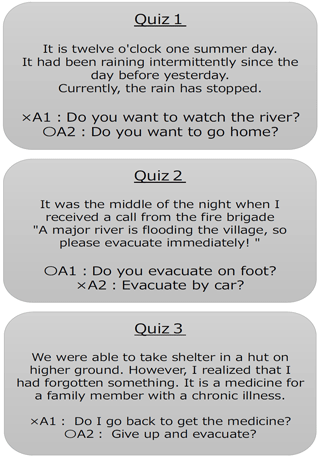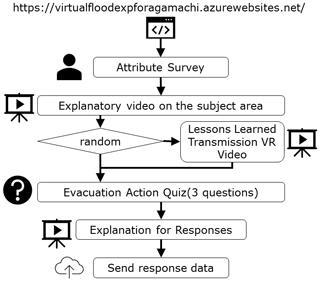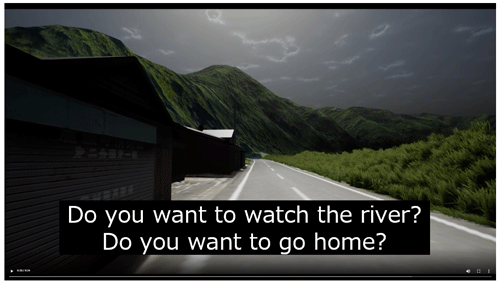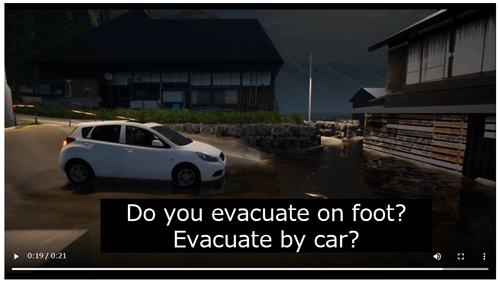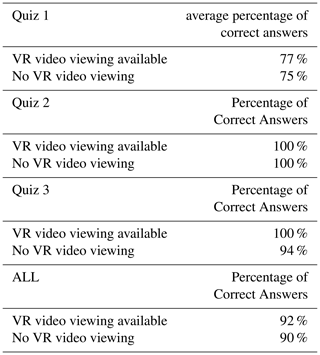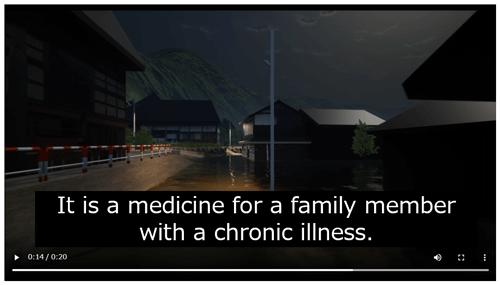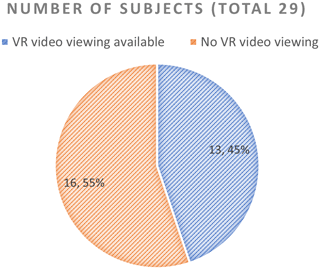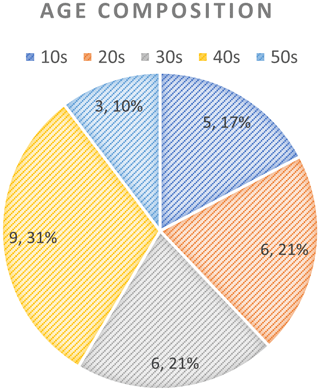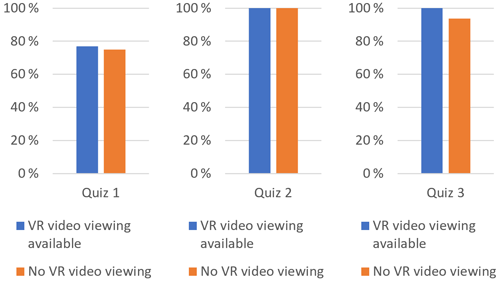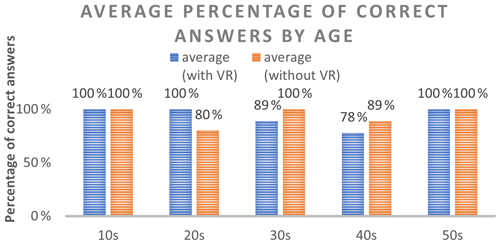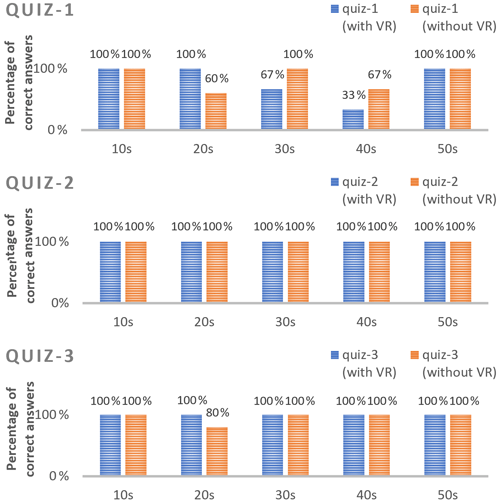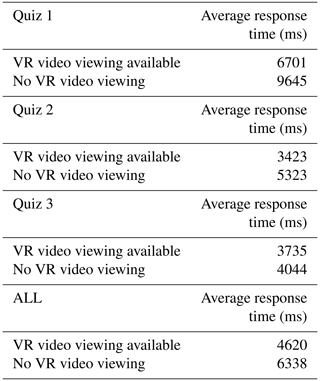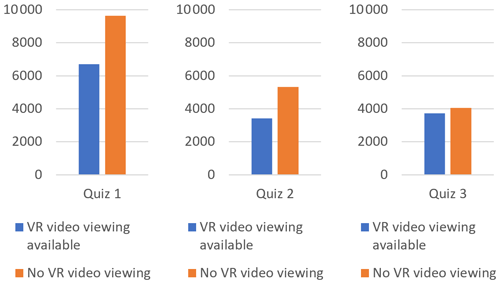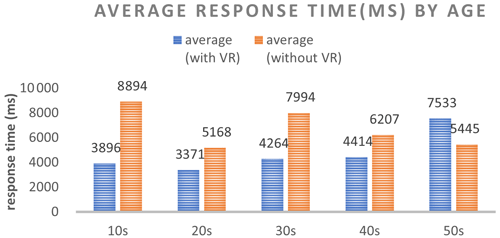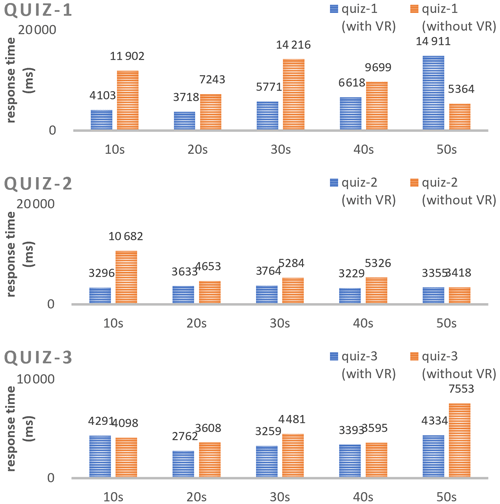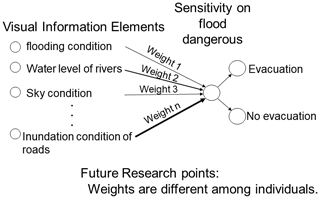the Creative Commons Attribution 4.0 License.
the Creative Commons Attribution 4.0 License.
A Study on Improving Disaster Mitigation Awareness by Simulated Flood Experience Using VR Videos
Tsuyoshi Koyabu
Masatoshi Denda
In recent years, the frequency of floods has been increasing every year, causing considerable damage, in particular, to human life due to delays in evacuation. In this research, a web page containing a questionnaire was created to investigate the changes in human action during floods to contribute to efficient disaster prevention and mitigation activities by residents and municipality officers in charge of disaster management. The subjects were made to watch videos created using Virtual Reality (VR) technology. The questionnaire on the web page was used to verify whether watching the VR videos would change people's attitudes toward disaster mitigation in the event of a flood. The results showed that the subjects who watched the VR videos were more likely to choose the correct action and the decision time to choose the action was earlier. These results indicate that VR videos can be used to raise awareness of efficient disaster mitigation actions during floods.
- Article
(2844 KB) - Full-text XML
- BibTeX
- EndNote
In Japan, water-related disasters occur every year due to climate change. The torrential rain in western Japan in 2018 resulted in more than 200 deaths. One of the factors contributing to the high death toll was delayed evacuation (Ushiyama et al., 2019). To implement early evacuation actions, it is important to effectively raise awareness regarding water-related disasters and provide disaster education to a wider population. There are various methods of disaster education for water-related disasters. It has been demonstrated that experiencing floods through virtual reality (VR) videos has proved to be effective (Kuribayashi et al., 2020). Researchers have studied the effects of using VR technology to enhance the evacuation awareness. They allowed people to imagine flood scenarios and experience evacuation during a flood using VR (Nagumo et al., 2022). Furthermore, research is being conducted to visualize the effects of river level forecasts in an easy-to-understand manner using VR to promote evacuations during floods (Morooka et al., 2022). In addition, flood disaster virtual reality applications have been developed in Japan (Fujimi and Fujimura, 2020), China (Pan et al., 2020), and Indonesia (Purnomo et al., 2022), demonstrating the effectiveness of using VR applications as flood education. There are operability issues to experience the application, especially for the elderly, who need to become accustomed to using the head-mounted display and controllers. On the other hand, viewing videos can be easily implemented by anyone. Disaster prevention education through VR videos is an easy mechanism that can be used worldwide to personalize the lessons learned videos to be passed on. VR videos have changed the way people experience floods, allowing “first-hand” experience by providing a virtual experience of flooding. In this study, an online questionnaire was created to investigate potential changes in the behaviors during a flood by viewing VR videos, which has been rapidly advancing in recent years. We aimed to prevent and mitigate disasters and disaster responses by residents and responsible officials effectively and efficiently. The VR videos were created by the Public Works Research Institute based on the lessons learned from actual flooding experiences. The information obtained from the questionnaire webpage was used to verify whether viewing VR movies containing lessons learned from previous disasters changed people's outlook toward disaster mitigation and floods.
2.1 Web Questionnaires
A questionnaire was filled by subjects who had and had not viewed the video of the lessons using VR. The quiz asked participants to select one of two options for three different situations: during a river flood, just before flooding, and after flooding (Fig. 1).
Note that because the quiz was designed for a certain model district, all subjects were asked to watch a video explaining the target district before answering the questions. The survey was conducted via the internet by creating a webpage for the survey. It consisted of a demographic survey of the subjects, a video explaining the target area, and answers to three quizzes (Fig. 2).
The quiz on the evacuation action was a video. It was answered after watching the video (Figs. 3–5). After answering each quiz, the participants were asked to judge whether they had taken the correct action or not. They were also asked to watch a video explaining the lessons learned from previous floods, so that they understood the correct course of action.
2.2 Characteristics of Subjects
The total number of respondents was 29. Viewing of the lessons-learned VR videos was randomly assigned on the webpage. Thirteen subjects viewed the lessons-learned VR videos, and 16 subjects did not view the videos (Fig. 6). The age of the subjects ranged from teens to 50s (Fig. 7).
3.1 Percentage of Correct Answers
The average percentage of correct answers on the quiz on subjects' evacuation actions was 92 % and 90 %, respectively, for subjects who did and did not watch the lessons-learned VR videos (Table 1 and Fig. 8). In addition, the percentage of correct answers for quizzes 1 and 3 was higher after viewing the lessons-learned VR videos. Quiz 2 was answered correctly by all participants.
A two-sample t-test was conducted to determine whether the difference in the percentages of correct responses with and without viewing the lesson-learned VR video was significant, assuming that the variances were different. The resulting p-value was 0.635, which was not less than the significance level of 0.05, and therefore was not considered to be a significant difference.
The percentage of correct answers did not change depending on whether the respondents in the age groups 11–20 and 51–60 had watched the VR video of the lessons learned. Conversely, the percentages of correct answers increased for participant ages 11–20 after watching the VR video of the lessons learned. However, the percentage decreased for those in the 31–50 age group. The trend remained identical for each quiz. There was no clear trend (Figs. 9 and 10).
3.2 Response Time
Next, the time required by participants to answer the questions was compared. For the answers on the webpage, we measured how long it took the respondents to answer the questions from the time they started watching the video. The duration of the question videos was approximately 2000 ms. In all quizzes, subjects who watched the lessons-learned VR videos responded more quickly (Table 2 and Fig. 11).
A two-sample t-test was also conducted for the response time, assuming that the variances were different. The results showed a significant difference for quiz 2, with a p-value of 0.043, which is below the 0.05 level of significance. Quiz 2 asked the participants to choose the means of evacuation. The correct answer is to evacuate on foot rather than by car. All subjects chose the correct means of evacuation; however, the decision was made more quickly by subjects who had viewed the lessons-learned VR video.
Younger teens quickly chose appropriate actions after viewing the lessons-learned VR videos (Fig. 12).
They selected appropriate actions quickly in quizzes 1 and 2. In quiz 3, 50s quickly selected the appropriate action by viewing the lessons-learned VR video (Fig. 13).
The results of the survey using a questionnaire webpage based on the video viewing showed that viewing the lessons-learned transmission VR video changed the awareness regarding the course of conduct during floods. Participants chose appropriate actions more quickly. This may be attributed to the fact that the subjects were given more information by the more realistic VR videos explaining the situation before and after the flood, in addition to text and voice explanations of the situation. The lessons-learned VR videos included the following information about the flood.
-
It is not raining; however, the major rivers have rising water levels.
-
Cars in parking lots are not flooded; however, the surrounding streets are flooded.
-
Surrounding roads and low houses are flooded at night.
The situational descriptions influenced the way the recipients of the information perceive the situation during a water disaster, depending on their awareness of disaster preparedness. Some subjects will respond to at least some important information (information with greater weighting) with the least amount of information and will choose to evacuate (Fig. 14).
The important information that elicits a reaction is strongly visual. The realistic visual situation created by VR deepens the understanding of the choice of evacuation action. It provides a better evaluation of the information and helps to decide to evacuate. Although the evaluation of the information is subjective, prior disaster prevention education and experience with actual disasters can provide more responsive information and better evaluation information. In the future, we would like to conduct experiments in a virtual space using VR technology to investigate what type of information leads to evacuation actions and factors influencing individual judgments. Although this is an initial experiment and the number of subjects is small, we plan to increase the number of subjects with different attributes in the future.
Since VR video viewing via the Internet can be effectively used in areas around the world where flood damage can occur, we would like to consider creating VR videos based on flood-damage cases and lessons learned not only in Japan but also internationally, and expanding the use of such videos to other districts in the future.
The results of the study of changes in actionable attitudes pre- and post-flooding by viewing the lessons-learned VR video revealed the following.
-
There is no clear effect of viewing the lessons-learned transmission VR video on the ability to choose appropriate actions.
-
Viewing the VR video of the lessons-learned can help people to quickly determine the appropriate evacuation actions.
The data is not publicly accessible. These data are about the psychological processes of individual subjects and must be treated with extra care in terms of research ethics.
TK and MD: Conceptualization; TK and MD: methodology; TK: software; TK: formal analysis; TK and MD: investigation; TK: writing – original draft preparation; MD: writing – review and editing; MD: supervision.
The contact author has declared that neither of the authors has any competing interests.
Publisher’s note: Copernicus Publications remains neutral with regard to jurisdictional claims made in the text, published maps, institutional affiliations, or any other geographical representation in this paper. While Copernicus Publications makes every effort to include appropriate place names, the final responsibility lies with the authors.
This article is part of the special issue “ICFM9 – River Basin Disaster Resilience and Sustainability by All”. It is a result of The 9th International Conference on Flood Management, Tsukuba, Japan, 18–22 February 2023.
We would like to thank the local government officials and residents of Aga Town for their tremendous contribution and cooperation during the field survey and interviews. We would also like to thank the students of the University of Tsukuba and the staff of IDEA Consultants, Inc. for their cooperation in the survey.
This paper was edited by Kensuke Naito and reviewed by Jagriti Mishra and two anonymous referees.
Pan, Z., Cheok, A. D., Müller, W., and Zhang, M.: A virtual reality training system for flood security, Trans. Edutainment, XVI, 126–134, Springer Berlin/Heidelberg, https://doi.org/10.1007/978-3-662-61510-2_12, 2020.
Fujimi, T. and Fujimura, K.: Testing public interventions for flash flood evacuation through environmental and social cues: The merit of virtual reality experiments, Int. J. Disast. Risk Re., 50, 101690, doi.org/10.1016/j.ijdrr.2020.101690, 2020.
Morooka, Y., Tsuchiya, S., Qian, C., and Takeshita, T.: Developing a river water level predicting system with 3D viewer using virtual reality technology, Advances in River Engineering, 28, 37–42, https://doi.org/10.11532/river.28.0_37, 2022.
Nagumo, N., Denda, M., Harada, D., Koike, T., Egashira, S., and Shinya, T.: An experiment of offering virtual evacuation experience program for flood damage mitigation, 51, https://doi.org/10.14866/ajg.2022a.0_51, 2022.
Purnomo, F. A., Yoeseph, N. M., Koesuma, S., Hartono, R., Ristania, S., and Riasti, B. K.: Virtual reality flood disaster with variations of water levels in the early warning system, The Institute of Electrical and Electronics Engineers, Inc. (IEEE) Conference Proceedings, https://doi.org/10.1109/APICS56469.2022.9918727, 23–24 August 2022.
Kuribayashi, D., Ohara, M., Koyabu, T., and Sawano, H.: A study on improving flood awareness and motivation for disaster mitigation by flood simulated experience using image video, Journal of Disaster Information Studies, 18, 35–45, https://doi.org/10.24709/jasdis.18.1_35, 2020.
Ushiyama, M., Honma, M., Yokomaku, S., and Sugimura, K.: Characteristics of victims caused by heavy rainfall disaster in July, 2018, Journal of Japan Society for Natural Disaster Science, 38, 29–54, https://doi.org/10.24762/jndsj.38.1_29, 2019.






